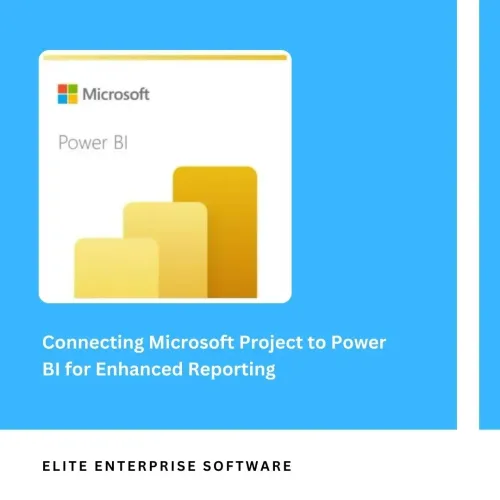Connecting Microsoft Project to Power BI for Enhanced Reporting

Integrating Microsoft Project with Power BI is an excellent way to enhance your reporting capabilities and take full advantage of the robust data analytics tools that Power BI offers. This integration allows you to visualize your project data, create custom reports, and access real-time insights into project performance. In this guide, we’ll walk you through the steps to connect Microsoft Project to Power BI, including how to access the necessary connections, set up your environment, and customize reports for more effective decision-making.
Getting Started: Accessing Power BI and Finding the Right Connection
The first step is logging into your Power BI account. On the left side of the homepage, you'll find the ‘Apps’ section. Click on this area, then in the upper right corner, select ‘Get Apps.’ Here, you’ll be able to search for relevant apps to connect with Microsoft Project.
To make it easier, simply type ‘project’ in the search bar. This search will return the relevant Microsoft Project connections available for integration with Power BI.
Understanding Different Project Versions and Their Connections
Depending on which version of Microsoft Project you are using—whether it's Project Desktop, Project Online, or Project for the Web—there are different paths for establishing the connection to Power BI.
Project Desktop or Project Online:
If you’re using Microsoft Project Desktop or Project Online, you’ll want to look for the connection that features the older project icon. Keep in mind that for Project Online, your project data must be uploaded to Project Web App (PWA) or Project Online for proper visibility within Power BI. This version of Project typically requires you to have your project uploaded and published in PWA.
Project for the Web:
If you are using Project for the Web, you will need to select the connection with the newer project icon. It’s important to note that Microsoft has announced plans to integrate Project for the Web with Microsoft Planner in the future, which may affect how the connection process works down the line.
Step-by-Step Guide to Connect Microsoft Project to Power BI
Now, let’s look at the steps required to establish a connection between Microsoft Project and Power BI, starting with the version of the Project you are using.
For Project for the Web:
Open the ‘Get Apps’ section in Power BI and look for the connection for Project for the Web.
Click the connection, accept the terms, choose a workspace, and install the app.
You’ll then need to connect your data by selecting the URL for your environment. This URL can be found within Power Apps under your default environment.
Once connected, Power BI will display a template with dummy data, giving you an initial setup to work with.
For Project Desktop:
In the ‘Get Apps’ section, locate the second-to-last option for Project Desktop.
Install the app by following the on-screen instructions and selecting your workspace.
To connect your data, you’ll need to enter the URL for your Project Web App (PWA) site. Make sure your projects are uploaded and published within the PWA for proper visibility in Power BI.
Customizing Reports and Utilizing Power BI Tools
Once your Microsoft Project data is connected to Power BI, you can begin customizing reports to suit your needs. Power BI offers a variety of options for viewing and analyzing your project data, including portfolio dashboards, timelines, and more.
Editing Reports:
To edit the reports, navigate to the workspace where your data is stored. From there, you can make changes to your existing reports and data models. You can tailor these reports to highlight the specific project details that matter most to you, including budget, timeline, and resource allocation.
Navigating and Creating New Reports:
You can explore different pages within Power BI, such as the portfolio dashboard or timelines, to get a more granular view of your project’s status. If needed, you can download the report files to Project Desktop for further customization, allowing you to tailor your visuals and graphs according to your preferences.
Key Takeaways and Tips for Success
Simplicity of Use:
One of the key benefits of connecting Microsoft Project with Power BI is how simple the integration process is. With the use of templates provided by Power BI, users can quickly connect their data and begin building reports, without the need for complex configurations.
Flexibility in Customization:
Once connected, Power BI gives users full control over their data. You can easily customize the reports, visuals, and graphs to reflect the information that matters most to your projects, providing a personalized reporting experience.
Stay Updated on Future Changes:
As Microsoft Project for the Web is set to integrate with Planner, be sure to stay informed about any updates regarding these changes. Such updates could affect the connection process, so it’s important to follow the latest developments from Microsoft.
Conclusion
Integrating Microsoft Project with Power BI enhances your ability to manage and report on project performance. Whether you’re using Project Desktop, Project Online, or Project for the Web, Power BI provides a seamless way to connect your project data and create impactful, customized reports. With Power BI’s flexible reporting tools, you can make informed decisions and drive project success with better insights and data analysis.
By following this guide, you’ll be equipped to connect Microsoft Project to Power BI and leverage its powerful features to enhance your project management and reporting efforts.
Read More: https://eliteenterprisesoftware.com/news/data-visualizations-with-microsoft-power-bi-pro/

